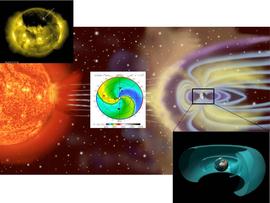On the solar wind impact on the terrestrial magnetosphere and radiation belts Sandrine Rochel
le 27 nov 2015 de10h00à 12h002015/11/27 2015/11/27

A magnetosphere is a bubble dropped inside the solar wind flux. She is distorted, compressed, dilated because of the solar wind variations. Moreover a magnetosphere allows entry of particles and energy from the solar wind through several processes. Entries inside the magnetosphere disturb the magnetospheric equilibrium and is responsible of changes in the currents density and of generation of waves. Those phenomenon allow to absorb the energy excess and to come back to the equilibrium state. In that point of view, they are very important as they prevent the magnetospheric crash. Nevertheless, the particles fluxes radiation belts located in the inner magnetosphere, close to the planet, can be strongly increased. In the terrestrial magnetosphere, satellites orbit in this region. During magnetospheric storms and substorms, the radiation belts can become very dangerous for on board instruments. This presentation is about the impact of solar wind structures on the radiation belts.




